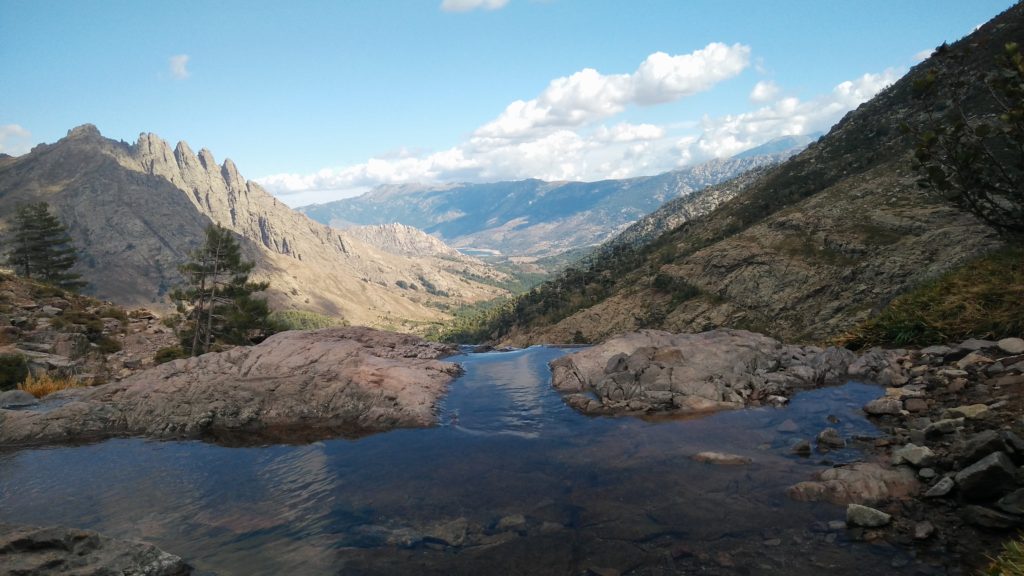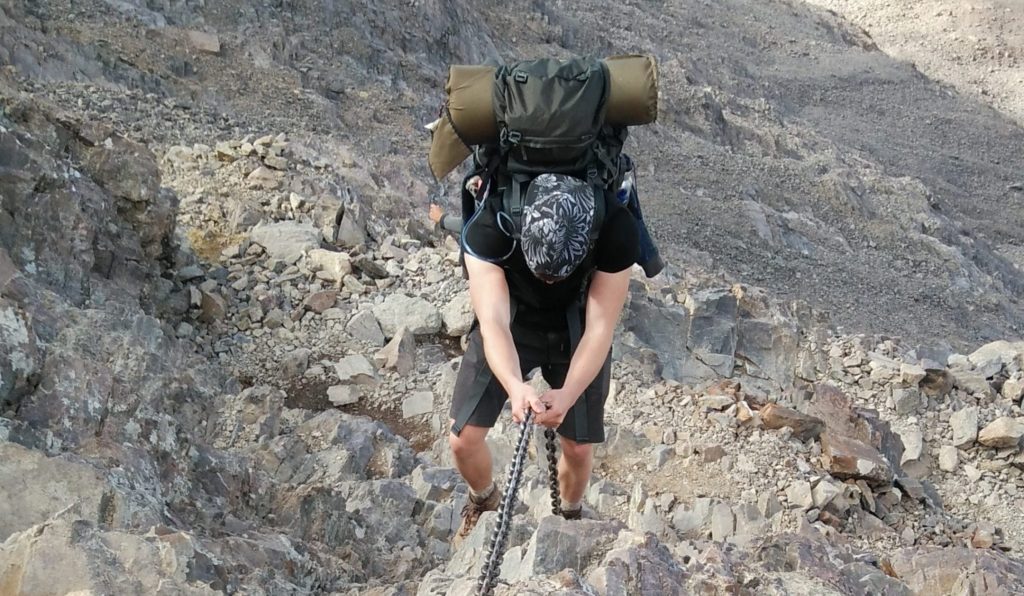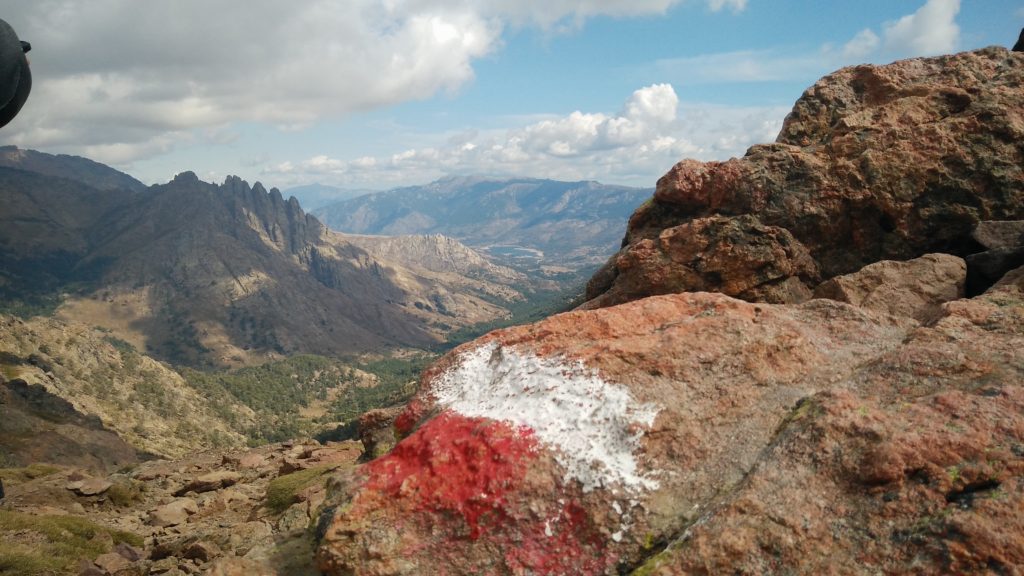Thinking about hiking the GR20 as a beginner? Well, the GR20 is known as the hardest long distance trail in Europe. So, do you need hiking experience? What about climbing experience? Do you need a great physique? Find out if hiking the GR20 as a beginner is possible and whether or not you are up for the challenge.

Can you hike the GR20 as a beginner? The quick answer is: yes hiking the GR20 as a beginner is possible. That said, a lot of beginners underestimate the trail and some suffering will be involved. You do not need any prior experience, but some training and good preparation is definitely recommended.
PS: for beginners who still need to buy a lot of gear, take a look at this article: Where to buy cheap hiking gear online. Getting started with hiking can be pretty costly, but not all high-quality hiking gear needs to be expensive.
How fit should you be to hike the GR20
Before I will answer this question, I should mention that someone with a bad physique but a very strong will can reach the end nevertheless.
That said, a lot of people mentioned that they did not expect the trail to be this heavy. If you give yourself more time to cover the same amount of distance, you will also make it easier for yourself.
However, you will have to walk at least a certain amount of miles before you reach the next place where you can sleep. Wild camping is an option (especially in emergencies), but it is legally not allowed. If you need to cover a big stretch, consider waking up very early, this way you will have more time to cover the same distance.
You do not have to be a professional athlete to finish the GR20, but doing some kind of exercise once in a while will definitely help. If you are not the most sportive type, I would recommend doing some training before hiking the GR20.
Go for some long day hikes with a heavy bag to get used to the feeling. Do not underestimate the combination of walking uphill and carrying a heavy backpack.
Even if you don’t have a great physique, hiking the GR20 is possible. However, you are probably going to suffer from time to time. Getting some training before starting the GR20 could make the trip a bit more enjoyable.
You might not need the best physique, but you should not have any health issues. If you do have certain health issues, it’s probably a good idea to consult your doctor before starting this adventure.
How dangerous and technical is the GR20
As I mentioned before, no prior experience is required. You do not need any technical climbing experience.
This does not mean that the trail is a piece of cake.
Especially on the northern part of the GR20, there are some places where the trail gets a bit more difficult and technical. On the most difficult parts there will be chains to support the hikers.


However, from time to time, there were spots where I thought to myself: “How am I supposed to get up there? There should be chains here”.


But at the end of the day, we did get up there. As inexperienced hikers, with a heavy backpack and zero climbing experience.
Most of the trail is easy to walk and is not very difficult or technical. The only thing to keep in mind is that the trail gets a lot more dangerous when it is raining. Try to avoid heavy rains and definitely storms as good as you can.
Stay up-to-date with the weather forecast as good as possible. This is probably the most important thing to ensure your safety. You do not want to be stuck in a storm on those mountains.
Is there any wildlife on the GR20? You might see some animals along the trail, but none of them are dangerous. No need to worry!
Navigate your way through the GR20
Let’s start by pointing out that the GR20 is extremely well marked and it is very likely that you will have no problems. However, it is nice to know how far you still need to go to get to the next shelter. Also, you want to have some sort of backup anyway, just in case you do get lost.


A simple paper pocket map is a must-have for any hiker. You should not have too much trouble finding one in Corsica. However, if you want to be safe and buy one in advance, you could buy one on amazon.
Now that we have a non digital backup, let’s start talking about how technology can help us. These days, there are plenty of advanced devices that you can use for navigation. Personally, I like to stick with my smartphone.
One website that was irreplaceable was one of the France government, https://www.geoportail.gouv.fr, you will see all the bergeries/refuges on the map, even the abandoned ones. We slept in a deserted bergerie: “Bergerie de Colga”, which was an amazing experience. We only knew about this because of that specific website
Also, we mainly used this website as our way of navigating (except for the trail markings of course).
Note that you will not always have reception on the GR20. Most of the time I had at least some reception, but from time to time it went completely dark. Therefore, it’s not a bad idea to download an offline copy of google maps.
If you are going to use your smartphone for navigating, you will need to find a way to charge it once in a while. You might be able to charge your phone once in a while on the trail, but don’t count on using a power plug every night. You can learn how to keep your phone charged in this article: How to keep your devices charged on the trail.
What to pack for the GR20
So, what should you pack for the GR20. Beginners often make the mistake of packing too much stuff. The truth is, you are not going to be able to shower every day and you will smell bad. So why would you bring fresh clothes? It’s just going to make your backpack heavier.
Clothes on the GR20
What clothes should you bring for the GR20? Well this article pretty much sums it up: Mountain hiking clothes: complete checklist. One thing I want to mention about that list, if you are going to hike GR20 during summer, you probably don’t need a puffer jacket. It won’t be that cold during the day.
You will probably also need a top notch waterproof hiking jacket. There is a lot of poor information about waterproof jackets on the internet (mainly brands/promotors who try to sell you stuff). This article: The 4 best waterproof hiking jackets does actually provide useful information.
It’s pretty obvious that you will also need good hiking shoes in order to successfully finish the gr20. Good hiking shoes do not necessarily have to be expensive, check out this article if you are interested: Best cheap hiking shoes.
Tent on the GR20
Hiking the GR20 without a tent is not impossible. However, most hikers will bring their own tent, I was no exception. Make sure you bring a good tent, the weather can be treacherous in the mountains.


We have seen a couple of collapsed tents during our time on the GR20. This is something you definitely want to avoid.
Bring a tent that is completely waterproof and make sure it can withstand a lot of wind. Note that the wind will be your main enemy. Finding a good place to put your tent can help, but often you will not be able to stay completely out of the wind.
There are plenty of good lightweight hiking tents out there. I went with the Quechua quickhiker ultralight 2, which is one of the best lightweight budget tents ever made in my opinion. I had no issues whatsoever on the GR20 with this tent.
Sleeping bag and sleeping pad on the GR20
Bringing a good sleeping bag is also very important. Make sure that your sleeping bag is at least comfortable for 0 degrees Celsius (= 32 degrees Fahrenheit).
An example of a very good sleeping bag that is not ridiculously expensive would be the Coleman Adult Mummy Sleeping Bag.
Except for a good sleeping bag, a sleeping pad is also very important. A sleeping pad is very important for staying warm during the night. Without a sleeping bad you will lose a lot of body heat to the ground.
Therefore, bringing a good sleeping pad is as important as bringing a good sleeping pad. You can’t go wrong with the Therm-a-Rest Z Lite Sol Ultralight.
Backpack on the GR20
Obviously, you are going to need a backpack. You want to make sure that this backpack feels comfortable while walking.
When it comes to size, I would advise bringing a 55 liter – 65 liter backpack. Remember, you do not want to bring too much stuff, so you don’t need the biggest backpack.
I went with the Nomad Batura 55 and I have no complains.
Must-have gadgets on the GR20
There are two gadgets that you should definitely bring on the GR20. A water filter/purifier and some paracord.
On a hot hiking day, it is recommended to drink a lot of water, three to four liters should be optimal. Obviously, you do not want to carry this amount of additional weight. Instead, you should carry one to two liters of water and refill whenever you get the chance.
Drinking from a spring or a fountain is always safe, but drinking directly from a stream is not considered safe. Therefore, you should purify that water before drinking it.
A paracord is needed on the GR20 because you won’t always be able to pin down your tent. The ground might be too hard, or you won’t have enough space. Instead, you can use paracord to attach your tent to a rock or something similar. You can see this on the picture of our tents.
Additionally, having some paracord could come in handy on many occasions.
Food on the GR20
As long as you hike during the season (June-September), you will be able to buy basic provisions at the refuges. Make sure to check if all the refuges will be open when you start hiking, you want to make sure you don’t run out of food.
I would recommend bringing enough food to last at least two days after leaving a place where you can resupply. You can also decide to have dinner or breakfast at most of the refuges (don’t expect too much).
If you want to have a decent dinner, there are restaurants at Haut Asco and Castel de Verghio. I would definitely not recommend to hike the GR20 during off-season if you are a beginner, you would have to bring a lot more food and if something happens you cannot seek help at a refuge.
For more information about eating healthy on the trail, I would recommend reading: How to eat healthy on the trail. Additionally, if you are interested in bringing the right hiking snacks check out this article: The 5 best hiking snacks.
What to avoid
The most important thing to avoid is to make the GR20 a race against the clock. If you have a plain to catch, you might take risks that you don’t feel comfortable with. You are both vulnerable to making mistakes because of exhaustion and because of the weather conditions.
Having a couple of days to spare is definitely recommended. This way you will be able to sit out a storm, instead of being forced to hike through the bad weather. Weather in the mountains is often unpredictable and can change last minute.
Also, if you have some days to spare after hiking the GR20, there are multiple other spectacular trails on Corsica. The “Desert des Agriates coastal trail” for example was very nice. You will not get bored!


Conclusion
Hiking the GR20 as a beginner is hard, but definitely not impossible. Try to get used to hiking with a heavy bag before you start your adventure. Also, make sure you bring all the gear you need without packing too heavy.
If you need to cover a long distance, make sure to wake early. This way you will have more time to cover the same amount of distance. You could walk at a slower pace and take more breaks.
Avoid dangerous situations by always checking the weather forecasts, and make sure to give yourself some spare days.
And of course, do not forget to enjoy. The trail is absolutely stunning, you might suffer from time to time. But once you reach the top of that mountain and you are rewarded by an amazing view, you will know it was worth it.
For more information on the GR20 you should check out the official website.